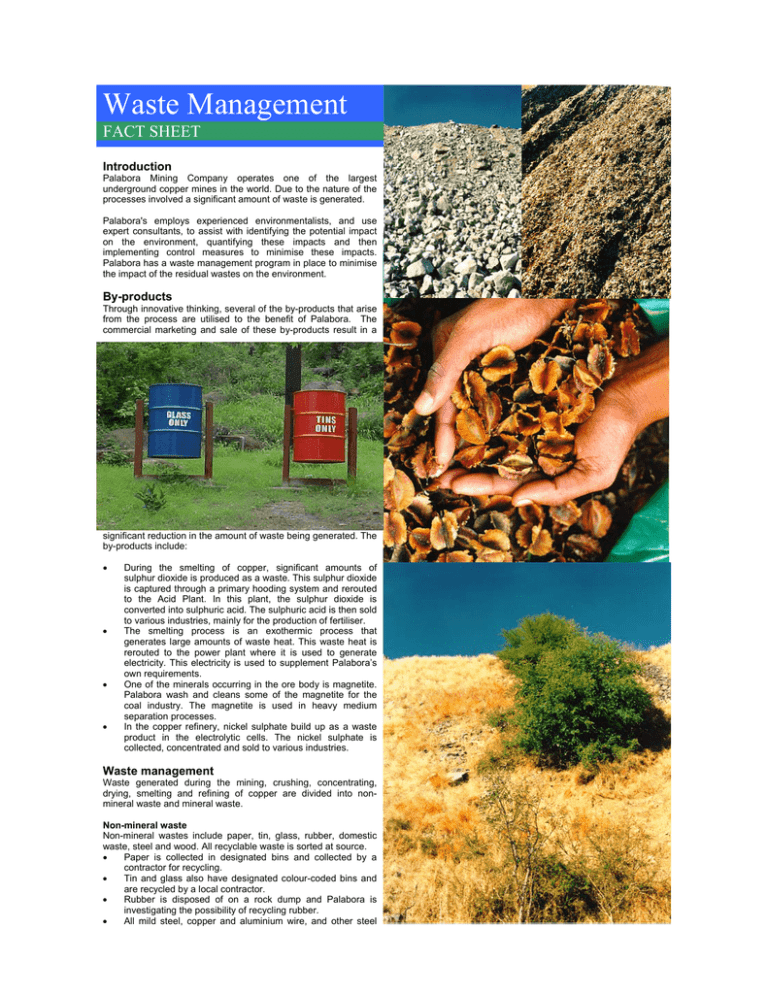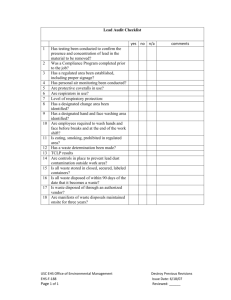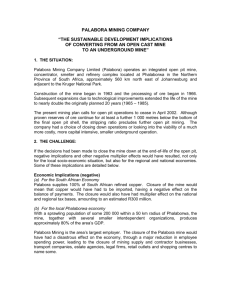Waste Management - Palabora Mining Company Ltd
advertisement

Waste Management FACT SHEET Introduction Palabora Mining Company operates one of the largest underground copper mines in the world. Due to the nature of the processes involved a significant amount of waste is generated. Palabora's employs experienced environmentalists, and use expert consultants, to assist with identifying the potential impact on the environment, quantifying these impacts and then implementing control measures to minimise these impacts. Palabora has a waste management program in place to minimise the impact of the residual wastes on the environment. By-products Through innovative thinking, several of the by-products that arise from the process are utilised to the benefit of Palabora. The commercial marketing and sale of these by-products result in a significant reduction in the amount of waste being generated. The by-products include: • • • • During the smelting of copper, significant amounts of sulphur dioxide is produced as a waste. This sulphur dioxide is captured through a primary hooding system and rerouted to the Acid Plant. In this plant, the sulphur dioxide is converted into sulphuric acid. The sulphuric acid is then sold to various industries, mainly for the production of fertiliser. The smelting process is an exothermic process that generates large amounts of waste heat. This waste heat is rerouted to the power plant where it is used to generate electricity. This electricity is used to supplement Palabora’s own requirements. One of the minerals occurring in the ore body is magnetite. Palabora wash and cleans some of the magnetite for the coal industry. The magnetite is used in heavy medium separation processes. In the copper refinery, nickel sulphate build up as a waste product in the electrolytic cells. The nickel sulphate is collected, concentrated and sold to various industries. Waste management Waste generated during the mining, crushing, concentrating, drying, smelting and refining of copper are divided into nonmineral waste and mineral waste. Non-mineral waste Non-mineral wastes include paper, tin, glass, rubber, domestic waste, steel and wood. All recyclable waste is sorted at source. • Paper is collected in designated bins and collected by a contractor for recycling. • Tin and glass also have designated colour-coded bins and are recycled by a local contractor. • Rubber is disposed of on a rock dump and Palabora is investigating the possibility of recycling rubber. • All mild steel, copper and aluminium wire, and other steel • products are collected for recycling. Wood is stored in a designated area for collection by external contractors for re-use. Palabora has a registered domestic waste site where all other non-mineral waste (typically domestic wastes) is disposed of. Mineral waste Mineral waste includes waste rock, tailings and slag. • During the life of the open pit, waste rock was dumped in a designated area named the waste rock dump. This dump has since been rehabilitated and re-vegetated. • Tailings from the concentrator are disposed of on one of two tailings impoundments. Magnetite tailings is stored on one of three dams for reprocessing. Copper tailings are disposed of on the copper tailings dam. These dams will be finally rehabilitated at mine closure. • Slag from the smelting process gets dumped in a designated area for rehabilitation at closure. Hazardous waste Hazardous waste is stored in 210l sealed drums and kept in a designated store before being disposed at a registered Class H:H landfill site. An external waste service provider collects contaminated oil for purification and reuse. Palabora conducts audits at the above-mentioned sites to ensure responsible environmental management and to give effect to the ‘cradle to grave principle’. For more information contact: The Principal Advisor SHEQ Johan van Dyk Box 65, Phalaborwa, 1390 +27 15 780 2281



